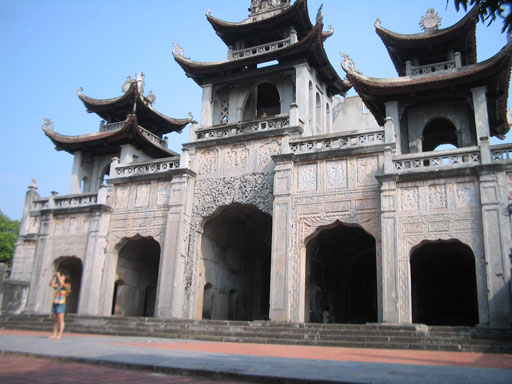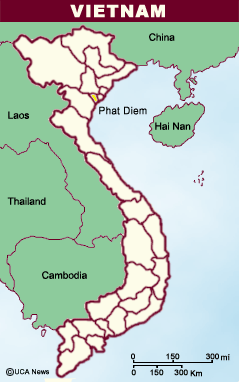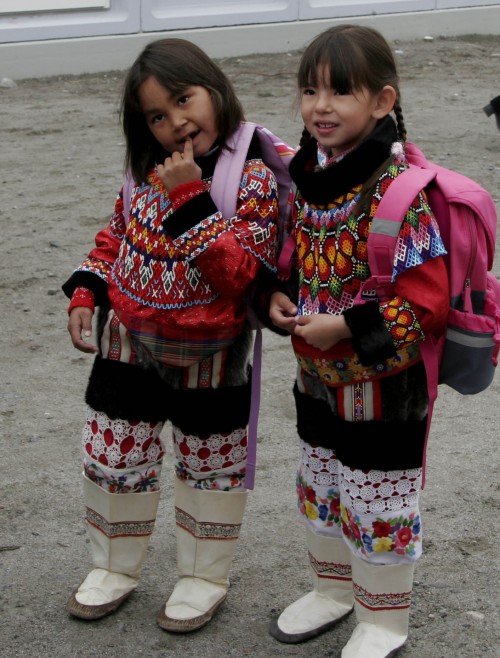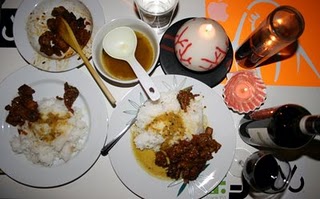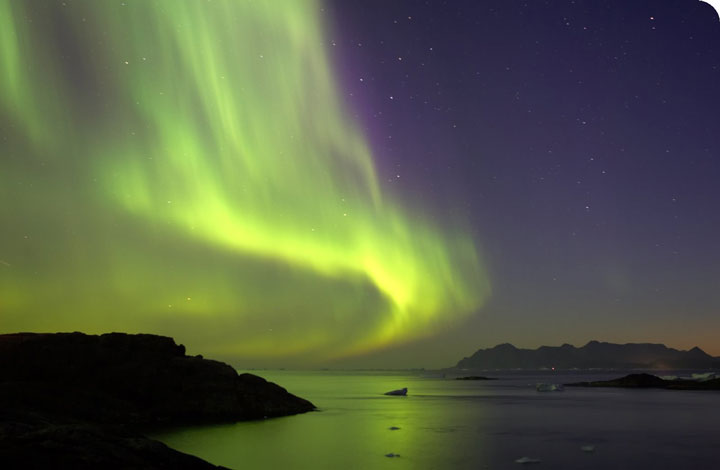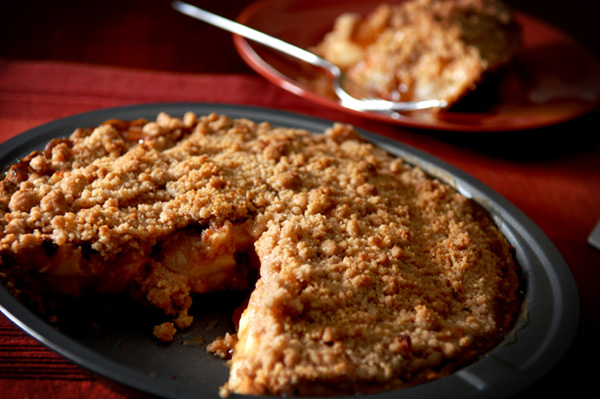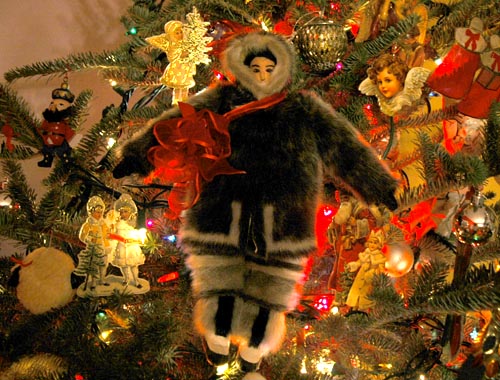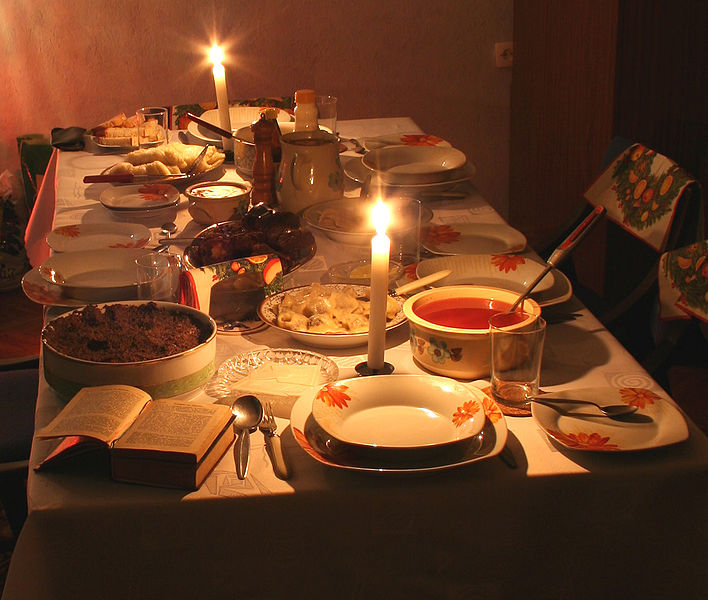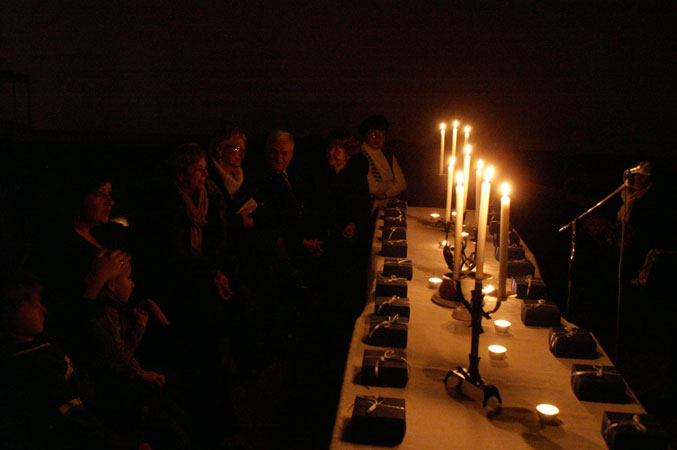Children dressed in Santa Claus outfits lineup before a Christmas celebration at a kindergarten in Hanoi, Vietnam, on December 24, 2009Christmas in Vietnam
The Vietnamese are a fun-loving, sociable people and the various Vietnam festivals and events are actually occasions for them to enjoy a gala time—Christmas in Vietnam is a grand party.Christmas is one of the four most important festivals of the Vietnamese year, including the birthday of Buddha, the New Year and the Mid-autumn Festival. Traditional Vietnamese religions are Buddhism and the Chinese philosophies of Taoism and Confucianism. However, during French rule, many people became Christians, that occupy eight to 10 percent of whose population. This is because the Vietnamese are a fun-loving, sociable people and the various Vietnam festivals and events are actually occasions for them to enjoy a gala time—Christmas in Vietnam is a grand party.
History Of Christmas In Vietnam
Christmas in Vietnam has had a tumultuous history. The Catholics are a minority in Vietnam but they used to celebrate Christmas in Vietnam quite in peace right from the days of the French rule. That is until the Communists took over political power in 1975. The church-state relations soured during that time and the Catholics were relegated to celebrating Jesus's birthday in privacy.
Since the end of the Vietnam War in 1975, church-state relations have not always been smooth. However, they have been improving since the introduction of economic reforms in the late 1980s. Liberalist policies adopted since the 1980s saw Vietnam warming up to western influences and ideals and Christmas in Vietnam came back triumphantly. Now Christmas is one of the major festivals in Vietnam, celebrated with much fanfare by all religious communities.
Phat Diem Cathedral in Ninh Binh Province is considered the spiritual home for the seven million Catholics who live in Vietnam, a predominantly Buddhist nation.Phat Diem Cathedral in Ninh Binh Province is considered the spiritual home for the seven million Catholics who live in Vietnam, a predominantly Buddhist nation. Hundreds of Catholics gather for Christmas Eve Mass in the northern city of Phat Diem. Children staged a nativity play to celebrate the birth of Jesus Christ - or Kito, as he is known in Vietnamese — in front of the city's cathedral, built in 1891.
Christmas in Vietnam is a huge event, especially in Ho Chi Minh City, Vietnam and the Vietnamese Christmas celebrations here are like any other city in the western world. The Christians in Vietnam attend a Midnight mass on Christmas Eve and return home to a sumptuous Christmas dinner. The Christmas dinner usually consists of chicken soup while wealthier people eat turkey and Christmas pudding.
On Christmas Eve, Vietnamese people in Hanoi and Ho Chi Minh City, especially young people, like to go into the city centre, where there is a Catholic Cathedral. The streets are crowded with people on Christmas Eve and in the city centre cars are not allowed for the night.
People celebrate by throwing confetti, taking pictures and enjoying the Christmas decorations and lights of big hotels and department stores. Lots of cafes and restaurants are open for people to enjoy a snack!
Children at the Go Vap Orphanage celebrate the Christmas season. Go Vap Orphanage provides food, housing, and education to about 200 children in the outskirts of Ho Chi Minh City. Many of the children, aged from newborns to eighteen years old, have mental or physical disabilities and the orphanage raises and educates them. The people who care for the children are loyal, caring and diligent, but sadly their resources are limited. The orphans' rooms are often filled to maximum capacity leaving little room for playing or personal space. ILACN donates supplies regularly to the orphanage and volunteers are needed to help with feeding, changing and playing with newborns and younger children or working with older children who need help with physical therapy activities. In May of 2009, the ILACN built a classroom for children who are visually impaired. The ILACN provides all the funds to keep the classroom running, including the teachers, specialized trainers and school supplies. ILA is marking its 10th year of service in Vietnam, having blossomed from one center in Ho Chi Minh City to nine centers across Vietnam. The organization is now the largest employer of qualified foreign English teachers in Vietnam and last year taught more than 30,000 students. To learn more about ILACN and its volunteer opportunities, visit http://www.discovereltvietnam.com/images/ELT/ELTapril10.pdf.Vietnam used to be part of the French Empire and there are still French influences in the Christmas traditions. Many Catholic churches have a big nativity crib scene or "crèche" with nearly life-size statues of Mary, Joseph, baby Jesus, the shepherds and animals. In some areas of Ho Chi Minh City, usually in Catholic parishes, people have big crib scenes in front of their houses and decorate the whole street, turning it into a Christmas area! These are popular for people to visit and look at the scenes.
Also like in France, the special Christmas Eve meal is called reveillon and has a bûche de Noël (a chocolate cake in the shape of a log) for desert. Vietnamese people like to give presents of food and at Christmas a bûche de Noël is a popular gift. Other Christmas presents are not very common, although some young people like to exchange Christmas cards.
The Yuletide spirit of giving and sharing has been embraced with an earnest by the Vietnamese. Generous as they are, the Vietnamese give out gifts and presents in plenty during the Christmas celebrations in Vietnam. However, the children are more keen to have their stockings and shoes stuffed in with goodies from Santa's bulging sack. The European customs of Santa Claus and the Christmas tree were popular and children would leave their shoes out on Christmas Eve.
(reprinted courtesy Vietnam-Beauty.com)
Merry Christmas in Vietnamese is "Chúc Múng Giáng Sinh"!***
Two children sport traditional Greenland dress.GREENLAND
Where Christmas Is So Good They Celebrate It Twice
Greenland's Christmas traditions are unique. Christmas trees have to be imported, because no trees grow as far north as Greenland. The trees are imported from Denmark—Iceland has had a long historical connection with Denmark—and are exquisitely decorated on the 23rd of December with candles, bright ornaments and often tiny little sealskin breeches (kamiks). However, occasionally a traditional driftwood tree is decorated with heather in its stead. In the weeks leading up to Christmas in Greenland, colorful decorations are displayed and illuminated Christmas stars are hung in many windows, their light symbolizing the birth of Jesus that brought light to the world. Above the Arctic Circle the sun doesn't rise in the winter, so the light these stars bring is a welcome respite from the ever-present darkness. (You might get a brief glimpse of Old Sol over the southern mountains, but that's it.) Villages, where possible, place large Christmas trees on nearby hills so that everyone in the vicinity can see them in time for the beginning of Advent. Another traditional and popular decoration is an illuminated star in the window. St Lucia's day (December 13th) is also celebrated in Greenland.
A typical traditional Greenlandic Christmas begins on the fourth Sunday before Christmas (the first day of Advent). In Greenland, this an important day celebrated in churches and homes. Local men may wear the white anorak for festive occasions, others may be in the traditional Greenlandic costume (see photo at top of page). In Greenland, the Polar Inuits spend Christmas visiting one another to celebrate this miraculous event. Greenlanders will drink coffee, eat cakes and exchange brightly wrapped parcels; traditional gifts are model sledges, pairs of polished walrus tusks or sealskin mittens. Everyone in the village gets a gift and children go from hut to hut, singing songs.
On Christmas Eve, there is a popular church service that is attended by many clad in the national Greenlandic dress or white anorak. Following comes the all-important dining tradition of coffee and cakes, along with mattak (whale skin with blubber) and kiviak (auk meat). Presents often include traditional model sledges for children or locally crafted clothing.
Christmas food in Greenland is unusual, too, and a particular favorite is mattak, a whale skin with a strip of blubber inside—since it's impossible to source these ingredients we won't include the recipe here. Kiviak is the raw flesh of small Auks (an Arctic bird) that are buried whole in sealskin for a few months; their decomposed flesh is regarded as a delicacy in Greenland. Suaasat is a thick soup of barbecued caribou, fish either as raw sushi or cooked, and the popular desert of Berries and Apples with Crisp Topping. Lots of Danish pastries are also consumed!
In addition to Kiviak, other popular Christmas foods in Greenland include Suaasat, and Apples with Crisp Topping.
Christmas in Greenland: 'The Sledge Song (We-Go)'One of the most endearing Christmas traditions finds the men looking after the women on Christmas eve—the men not only serve food to the women, they serve and stir their coffee too. After the Christmas meal, the games begin. In one popular game, an object is passed from hand to hand around a long table under the cloth. It is supposed to be repulsive: round, clammy and rough in texture, such as a frozen egg, wrapped in strips of wet fox fur.
In Greenland two main languages are spoken, Inuit/Greenlandic and Danish. In Greenlandic, Happy/Merry Christmas is "Juullimi Ukiortaassamilu Pilluarit"; in Danish it is "Glædelig Jul."
Greenland also claims to be the place where Santa Claus lives or at least goes for his summer holidays. He is said to have a home in the north of the country in Spraglebugten, near the town of Uummannaq.
When Christmas is over, Greenland quiets down and awaits the New Year. The locals actually celebrate it twice. There's the Danish New Year at 8 p.m. Greenland time and then the true Greenlandic New Year is celebrated at midnight local time. It's a beautiful sight when you catch the Northern Lights at the same time.
Kangerlussuaq on Greenland's west coast is one of the best places in the world to see the Northern Lights.
***
Apple and Berry Crisp: A Greenland Favorite
Ingredients:
• 4 large cooking apples, peeled and sliced or coarsely chopped
• 17 ounces raspberries
• 250 8 ½ ounces blueberries
• 1/3 cup granulated sugar
• 2 tbsp butter, grated
• 2/3 cup melted butter
• ¼ cup brown sugar
• 1 cup cake flour, sifted
• 1/4 tsp bicarbonate of soda
• ¾ cup quick cooking rolled oatsMethod:
• Pre-heat oven to 180C and grease oven dish.
• Combine the sliced apples, the berries, and the granulated sugar and toss them to coat, dot with the grated butter.
• Mix the melted butter with the brown sugar, the flour, the salt, the bicarbonate of soda and the rolled oats an sprinkle this mixture evenly over the fruit.
Bake until fruit is tender and topping is crunchy and golden brown.
An Inuit Christmas tree decoration***
Christmas In Lithuania
Of Family, Food and Christmas JoySupper on Christmas Eve is special and traditional. The whole family gathers together. All family members make an effort to come home for the Christmas Eve supper, even from a distance. Perhaps not so much for the meal as for the sacred family ritual which draws the family members closer, banding everyone and strengthening warm family ties. If a family member has died that year or cannot attend the meal (only for very serious reasons) an empty place is left at the table. Everyone gathers at the dinner table as soon as the first star appears in the sky.
Christmas Eve is more important than Christmas day in Lithuania. Dec. 24th is the shortest day of the year. All traditions are related to it. The whole week has been spent cleaning the house. Preparations for Christmas Eve take all day, food prepared not only for the special supper (Kûèios) but also for the first day of Christmas. People fast and abstain from meat. It is vitally important that the Christmas Eve supper include no meat dishes because it could then no longer be called Kûèios but an ordinary meal prepared for any other evening.
On Christmas Eve the house must be thoroughly cleaned, all the bed linens changed and all family members must bathe and don clean clothes before the evening meal. For the Christmas Eve dinner, the table is prepared as follows: a handful of fine hay is spread evenly on the table. This is a reminder that Jesus was born in a stable and laid in a manger on hay. The table is then covered with a pure white tablecloth, set with plates and decorated with candles and fir boughs. A small plate with as many Christmas wafers as there are persons present is placed in the center of the table. In some Lithuanian regions these wafers were called God's cakes (Dievo pyragai) for they were obtained from the parish and were imprinted with Biblical scenes of Jesus' birth. Although plotkelë was the popular and better known term, the word is borrowed from the Slavic.
Supper on Christmas Eve is special and traditional. The whole family gathers together. All family members make an effort to come home for the Christmas Eve supper, even from a distance. Perhaps not so much for the meal as for the sacred family ritual which draws the family members closer, banding everyone and strengthening warm family ties. If a family member has died that year or cannot attend the meal (only for very serious reasons) an empty place is left at the table. If you know that there is a person alone anywhere, you must invite him/her to Christmas Eve supper. Eating together and sharing with others is the most important thing.
Twelve different dishes are served on the table because Jesus had twelve apostles. All the dishes are strictly meatless: fish, herring, slizikai with poppy seed milk, kisielius (cranberry pudding), a dried fruit soup or compote, a salad of winter and dried vegetables, mushrooms, boiled or baked potatoes, sauerkraut (cooked, of course, without meat) and bread.Twelve different dishes are served on the table because Jesus had twelve apostles. All the dishes are strictly meatless: fish, herring, slizikai with poppy seed milk, kisielius (cranberry pudding), a dried fruit soup or compote, a salad of winter and dried vegetables, mushrooms, boiled or baked potatoes, sauerkraut (cooked, of course, without meat) and bread. In keeping with Lithuanian Christmas tradition, only the dishes as they were prepared in Lithuania for this meal should be eaten and fresh fruit, fresh vegetables, exotic seafood should be left for another meal. It must not be forgotten that Lithuania is a northern European country where cucumbers, tomatoes, grapes, etc., do not grow in winter. The people whose lifestyle produced the Kûèios traditions made do with foodstuffs prepared in the summer and fall: dried, pickled and otherwise preserved for the winter.
Everyone gathers at the dinner table as soon as the first star appears in the sky.
Christmas Eve in LithuaniaIf the night is cloudy, the meal begins when the father or grandfather announces it is time to eat. When everyone is assembled at the table, a prayer is said. The father then takes a wafer and offers it to the mother wishing her a Happy Christmas. "God grant that we are all together again next year", the mother responds and breaks off a piece of wafer. She offers the father her wafer in return. The father then offers his wafer to every family member or guest at the table. He or the oldest member of family wishes the best wishes for everyone. The mother does likewise. After them, all the diners exchange greetings and morsels of wafer. If apples are placed on the table, the mother takes an apple after the wafers have been shared, cuts it into as many pieces as there are diners and gives the father the first piece. This symbolized the fall of the first parents when Eve gave Adam the apple, which he took and ate. Then, the apple pieces are distributed to those at table.
The order of eating the other dishes is not established, everyone eats what he wishes, but it is essential to at least taste every food. Whoever skips a Kûèios dish will not survive until the next Christmas Eve. The meal is eaten solemnly, there is little conversation or joking and alcoholic beverages are not served. If anyone needs to drink, water, homemade cider or fruit juice is served.
For a hot meal, I usually prepare dumplings, shaping them into ears, with dried boletus inside. These dumplings are served with hot broth make from red beet roots and boletus broth. It is particularly tasty.
After finishing the main dishes, the family awaits the coming of Christmas Man, who leaves his sack at the door, filled with homemade gifts.As soon as we eat the main dishes, we pause to wait for the coming of Christmas Man (your Santa Claus). When the children were small, he used to come with a big sack full of gifts.
Now that our family are all adults, he "leaves" the sack behind the door. Everyone gets many gifts, which we have prepared for each other.
Everyone is very pleased. After this large dinner, we eat special sweet courses: very sour thick cranberry kissel (jelly made with potato flour), mixed, stewed fruit compote, and a special Christmas Eve dish of with poppy seed milk, poppy seed milk with very small dumplings (lumps) slipikai.
In earlier times, the man of the house always took food from the Christmas Eve table for the animals to the cattle shed. The belief was that people and animals would be friendly in the year to come, doing nothing bad to each other.
This night is always mysterious. Even the animals begin to speak in the cattle shed at midnight. You can go and listen to them. Christmas Eve is rich in prognostications. The night is very full of lots. It is a tradition to cast lots. As soon as the family has supper, the mother pours grains of wheat on the table. The more you pick up, the richer you will be next year.
The girls draw straws from under the tablecloth. The shortest straw means the girl will marry, the thickest means the girl will be happy. If you are angry with someone on Christmas Eve, you will be angry in the new year.
Holiday scenes from the Lithuanian winter, in the cities of Vilnius and Siauliai. Posted on YouTube by AurisN.If it is a starry night after supper, it means the new year will be good. Hens will lay many eggs, forest mushrooms will be plentiful, the apple and nut harvests will be large next year. If it snows after supper, the cows will give lots of milk. There are lots of other lots that night. After presents were changed, the children usually went to bed while the adults went to Midnight (which is still called Berneli¸ midios—Shepherds' Mass).
It should be mentioned here that at Christmastime Lithuania is already in the grip of winter. The fields are covered with sparkling snow, streams, rivers and lakes are under ice. Country roads were also snows covered and the people usually traveled in sleighs. On Christmas Eve night bells were attached to the horses' harnesses: sometimes one or two or an entire string of bells. Sometimes small, high-pitched handballs or a good-sized bell. From all sides on Christmas Eve night resounded with the chiming and tinkling of bells: near and far, soft and loud . . . The mysterious, quiet night air of Christ's Birth resonated with endless ringing, the murmur of sliding sleighs and Christmas joy.
‘Silent Night,’ St. Peter and Paul’s Cathedral, Siauliai, Lithuania, December 31, 2008
Founder/Publisher/Editor: David McGee
Contributing Editors: Billy Altman, Laura Fissinger, Christopher Hill, Derk Richardson
Logo Design: John Mendelsohn (www.johnmendelsohn.com)
Website Design: Kieran McGee (www.kieranmcgee.com)
Staff Photographers: Audrey Harrod (Louisville, KY; www.flickr.com/audreyharrod), Alicia Zappier (New York)
E-mail: thebluegrassspecial@gmail.com
Mailing Address: David McGee, 201 W. 85 St.—5B, New York, NY 10024



